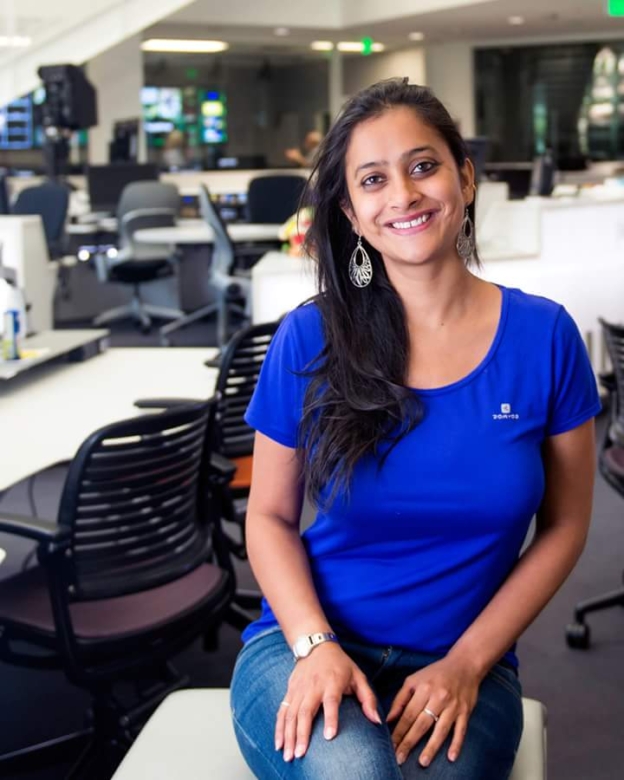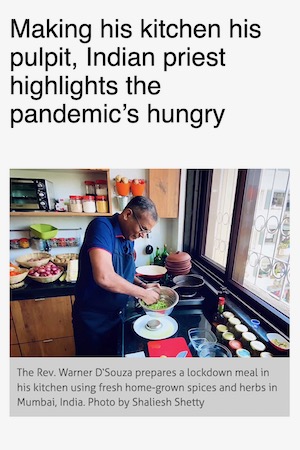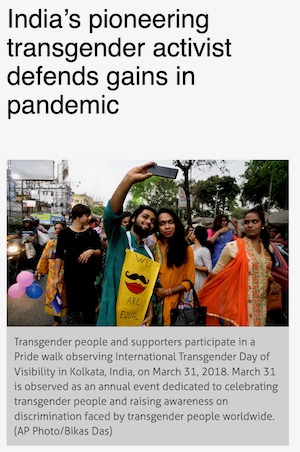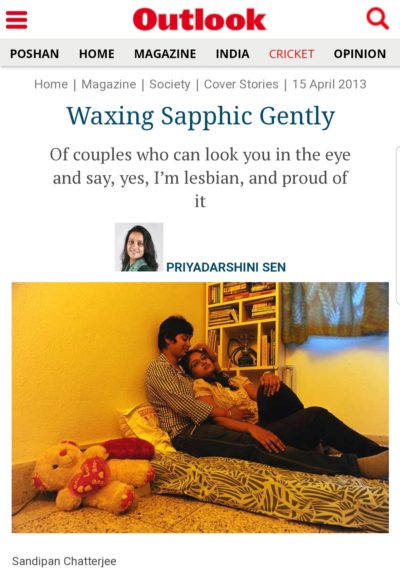Spotlight on Priyadarshini Sen in India
A CONVERSATION WITH … Priyadarshini Sen

Based in New Delhi, Priyadarshini Sen’s work is focused on how religion intersects with politics, social justice, public policy, culture and social issues. She focuses especially on people living on the fringes of society and draws their concerns into the mainstream. She’s particularly interested in reporting on discrimination against sexual minorities, disenfranchisement of refugees and minority groups, religious polarization, and solidarity-building efforts during acute crises.
Since COVID-19, she has been focusing on stories that illuminate the role of religion in forging community ties amid the pandemic. Some of her reporting is produced as part of the Spiritual Exemplars Project fellowship with the University of Southern California’s Center for Religion and Civic Culture.
Q:
What are the most prominent issues in your region?
A:
Over the last few years, religion and politics have come too close in South Asia. Governments have pushed ahead with their aggressive religio-political agendas that have alienated minorities and deepened religious polarization. Earlier, secularism was a counterweight to discrimination by nation states on grounds of religion but that has been reversed. Consequently, the space for dissent and expressions of heterodox faiths is shrinking alarmingly, and anyone who speaks in favour of minorities is branded an anti-nationalist. Religion now tends to be linked to citizenship. Last year, the Indian Parliament approved the Citizenship Amendment Act (CAA) guaranteeing citizenship rights to refugees from six minority religious communities of Bangladesh, Pakistan and Afghanistan. However, the exclusion of Muslims from these minority groups touched off widespread peaceful protests across India and beyond. In response, the government cracked down and arrested many anti-CAA protesters.
Last year, the Indian government also stripped the only Muslim-majority state of Kashmir of its autonomy by revoking Article 370. This had allowed the state its own Constitution, a separate flag and relative freedom to make laws. The abrogation of Article 370 led many to believe it was intended to alter the demographic landscape of Kashmir by allowing non-Kashmiris to buy land there.
Claims by Hindu nationalists to the hypothesized birthplace of Lord Rama on the site of the now-demolished Babri Masjid in Ayodhya have also triggered widespread Hindu-Muslim violence over the last few years.
Religion-based violence and repression have swept other parts of South Asia, such as Pakistan, Bangladesh and Sri Lanka. State-led persecution of minorities and heterodox faith groups are now threatening to become routine.
Since the outbreak of the pandemic, religious minorities have been blamed for spreading the virus, assaulted, pushed out of jobs and neighbourhoods, and denied medical care. The health crisis has not only fanned religious hatred, but also provided motivation and cover for increased persecution of minority faith groups.

Q:
What stories are you currently writing about?
A:
I’m currently focusing on stories that illuminate the role of religion in forging community ties amid the pandemic. I’m also working on stories that connect religion with politics, culture, social justice and human rights issues. My column Dharma Unspooled for Outlook Magazine is an attempt to think about religious discriminations, solidarity-building efforts, intercultural dialogue, modalities of faith, and minority rights in these unprecedented times. For instance, one of my recent columns was about the therapeutic spirituality of indigenous people and why they are better prepared to recalibrate for the future.
Through the Spiritual Exemplars Fellowship, I’m highlighting both exemplary and ordinary people who are responding heroically to the pandemic. One of my stories was about a Mumbai-based pastor who is sharing recipes, reflections and liturgies online as part of a series of lockdown lessons about food and spirituality.
Making his kitchen his pulpit, Indian priest highlights the pandemic’s hungry

I also highlighted one of India’s pioneering transgender activists, who, amid unemployment and threats to health care coverage due to the pandemic, has summoned her support networks to keep the community’s still fledgling hopes alive.
India’s pioneering transgender activist defends gains in pandemic
Q:
How did you become interested in covering religion?
A:
I grew up in a very secular environment where spirituality was a personal choice and private pursuit. We read books and articles about spirituality, and attended religious festivals and interfaith gatherings. But I never imagined I would specialize in religion reporting and that it would transform my life. In my initial years as a professional journalist, I worked on several stories where religion was an ingredient but it never held out as the primary focus.
While pursuing my Master’s in Specialized Journalism at the University of Southern California in 2016, I specialized in religion reporting. It was through my own readings, classroom lessons and mentorship from my teachers that I realized it would become my focus. The conviction was not forced, and I knew religion would lead me to people with various political ambitions, social and cultural convictions. It would not only be challenging professionally, but also help me grow as a person.
Q:
Why do you think religion reporting is so important?
A:
Religion reporting exposes you to a wealth of characters, plots, stories and circumstances. It pushes you into unchartered areas, disrupts or reshapes your beliefs, helps you embrace diversity, and makes you acutely aware of the plight of the marginalized and vulnerable. If communities, ethnic minorities and refugees interest you, religion reporting is possibly the best way to gather insights on the way people live, work, think, disagree and synergize.
Religious commitments are one of the most powerful identity markers in society, so a religion reporter has to be sensitive and open-minded while interviewing subjects from different walks of life. She must also see herself as a key contributor to the wellbeing of society. So, along with a critical mindset and an eye for details, an empathetic approach goes a long way in understanding and respecting the idiosyncrasies of faith.
Q:
Tell us about a story you wrote that was particularly meaningful to you.
A:

In 2013, I worked on a story about lesbian couples in India for Outlook Magazine: Waxing Sapphic Gently
This was at a time when homosexuality was illegal in India, and gays and lesbians were subjected to extreme ostracization, abuse and coercion. Over the course of six months, I interviewed over 50 couples from an invisible community whose lives had rarely been documented before. Despite their fragile support systems, these couples agreed to shed the garb of their semi-secret lives and come out with their names and identities intact. It was an extremely gratifying experience, which also marked the beginning of my work on sexual minorities.
Q:
How can we, as a community of journalists, improve reporting on religion, making it accurate and interesting while avoiding sensationalism?
A:
It’s critical for those reporting religion to understand the nuances of faith-related stories and take cognizance of the fact that they are never one-dimensional. Religion journalists must also be prepared to interview subjects in conflict zones and areas where mass human rights abuses and atrocities have taken place. As a community, it’s important for us to develop resources and tools that could enhance stories with global implications. The coverage of religion often lacks adequate understanding or sensitivity to cultural mores.
Effective collaboration can break down prejudices that create a smokescreen for understanding critical issues. Working as a community can also build trust, enhance the collaborative spirit and bring together multimedia skills in a more persuasive manner.
Q:
You often cover sensitive and underreported issues in your articles. What are the main challenges that you faced as a female journalist reporting on faith and religion?
A:
Women covering religion may have to report contentious issues in places where communal riots may have broken out or which may be deeply polarized along religious lines. Independent journalists, additionally, may have to venture into these areas alone, so judgement and safety are key factors to be kept in mind. Also, religion exposes you to many cultural and social attitudes along with ritualistic beliefs that may be unknown to you, so having an open mind is critical. Since religion encompasses a range of issues, it’s important to turn to multiple sources to gain perspective, verify and make space for multiple voices.
While reporting in conflict areas, women covering religion could easily be silenced, stereotyped or targeted. I’ve realized the power of silence while interviewing my subjects who often need to vent instead of feeling they are being spotlighted.
Priyadarshini’s adivce for reporters interested in covering religion:
For those interested in covering religion, it’s important to keep in mind that our primary role is to enhance people’s understanding of the world around us.
Religion isn’t only about the appeal to tolerance but speaks to a broad canvas of issues such as human rights, culture, environment and public policy. We need to avoid derogatory stereotypes, challenge assumptions and be sensitive to beliefs and practices that are contrary to ours. Informed reporting also holds governments and civil societies accountable and sparks democratic debates.
For anyone keen on reporting globally, it’s important that we collaborate so that the stories are more cogent and have a broader appeal.
The best way to see Priyadarshini’s ongoing work is to follow her Twitter Account @PriyadarshiniS_
